Spatial Zoning of Dry-Hot Wind Disasters in Shandong Province
Abstract
:1. Introduction
2. Materials and Methodology
2.1. Study Area
2.2. Data Sets
2.3. Methods
2.3.1. Basic Theory of Disaster Risk Assessment
2.3.2. Weighted Comprehensive Evaluation Method
2.3.3. Analytic Hierarchy Process
2.3.4. Standardization
2.3.5. Arc-GIS Spatial Analysis
3. Results
3.1. Spatial Distribution of Dry-Hot Wind Risk
3.1.1. Zoning of Meteorological Factor Risk
3.1.2. Zoning of Disaster Environment Sensitivity
3.1.3. Zoning of Dry-Hot Wind Risks
3.2. Spatial Distribution of Exposure of Disaster-Bearing Bodies
3.3. Spatial Distribution of Vulnerability of Disaster-Bearing Bodies
3.4. Spatial Distribution of Disaster Prevention and Mitigation Capability
3.5. Spatial Distribution of Comprehensive Risk of Dry-Hot Wind Disasters
4. Discussion
5. Conclusions
Author Contributions
Funding
Institutional Review Board Statement
Informed Consent Statement
Data Availability Statement
Conflicts of Interest
References
- Ma, Y.L.; Luan, Q.; Li, W.W.; Liu, W.P. Distribution Characteristics of Dry-hot Wind and Its Effect on Yield of Winter Wheat in Shanxi province. J. Shanxi Agric. Sci. 2017, 45, 1134–1138. [Google Scholar] [CrossRef]
- Li, J.H.; Zhai, B.L. Harm of hot dry wind to wheat and its preventive measures. Henan Agric. 2021, 7, 39. [Google Scholar] [CrossRef]
- Zhang, Z.H.; Cheng, L.; Li, S.L.; Peng, J.Y.; Fang, W.S. Dry-hot wind effects on physiology of winter wheat. Chin. J. Ecol. 2015, 34, 712–717. [Google Scholar] [CrossRef]
- Xu, Y.N.; Wu, Y.; Liu, B.H.; Song, J.Q.; Lv, G.H.; Ji, B.Y.; Zhang, W.Y.; Yang, Z.L.; Bai, W.B. Effect of Dry-Hot Wind on Grain Weight of Winter Wheat at Different Spikelet and Grain Positions. Chin. J. Agrometeorol. 2021, 42, 583–595. [Google Scholar] [CrossRef]
- Jin, F.G. Impact of dry and hot winds on wheat and countermeasures. Mod. Agric. Sci. Technol. 2021, 10, 19. [Google Scholar]
- Reeves, T.G.; Cassaday, K. History and past achievements of plant breeding. Aust. J. Agric. Res. 2002, 53, 851–863. [Google Scholar] [CrossRef]
- Dhonde, S.H.; Kute, N.S.; Kanawade, D.G.; Sarode, N.D. Variability and characters association in wheat (Triticum aestivum). Agric. Sci. Dig. 2000, 20, 99–101. [Google Scholar]
- Sofield, I.; Evans, L.; Cook, M.; Wardlaw, I. Factors Influencing the Rate and Duration of Grain Filling in Wheat. Aust. J. Plant Physiol. 1977, 4, 785–797. [Google Scholar] [CrossRef]
- Huo, Z.G.; Shang, Y.; Wu, D.R.; Wu, L.; Fan, Y.X.; Wang, P.J.; Yang, J.Y.; Wang, C.Z. Review on Disaster of Hot Dry Wind for Wheat in China. J. Appl. Meteorol. Sci. 2019, 30, 129–141. [Google Scholar] [CrossRef]
- Ivanov, B.K. Conditions and characteristics of dry hot air in West Siberia. In M. Literature Data of Dry Hot Air in the Soviet Union; Shanxi Provincial Meteorological Bureau: Jinzhong, China, 1982; pp. 34–58. [Google Scholar]
- Tavakol, A.; Rahmani, V.; Harrington, J. Temporal and spatial variations in the frequency of compound hot, dry, and windy events in the central United State. Sci. Rep. 2020, 10, 15691. [Google Scholar] [CrossRef]
- Viktorovich, P.R.; Aleksandrovna, V.A.; Vladimirovich, S.K. Recurrence of hot dry winds on the territory of Lower Volga region. J. Sci. Rev. 2014, 5, 41–46. [Google Scholar]
- Hou, Q.; Zhang, B.; He, H.; Li, S. Effects of Climate Change on Characteristics of Dry-hot Wind in Hexi Region of Gansu province. Plateau Meteorol. 2020, 39, 162–171. [Google Scholar] [CrossRef]
- Cheng, L.; Zhang, Z.H.; Chang, J. Analysis on the Change of Dry-hot Wind Hazard for Winter Wheat in Last 47 Years in Henan province. Chin. J. Agrometeorol. 2011, 32, 455–456. [Google Scholar] [CrossRef]
- You, F.C.; Hao, L.S.; Shi, Y.S.; Duan, S.L.; Sun, F.C. Causation analysis of Dry-Hot Wind Formation in Hebei province Winter Wheat Region. Meteorol. Mon. 2007, 3, 95–100. [Google Scholar] [CrossRef]
- Li, S.; Zhang, L.; Huang, B.X.; He, L.; Zhang, J.F.; Guo, A.H. A comprehensive index for assessing regional dry-hot wind events in Huang-Huai-Hai Region, China. Phys. Chem. Earth Parts A/B/C 2020, 116, 102860. [Google Scholar] [CrossRef]
- Shi, B.L.; Zhu, X.Y.; Li, H.Z.; Hu, Y.C.; Zhang, Y. Analysis of how dry-hot wind hazard has changed for winter wheat in the Huang-huai-hai plain. Nat. Hazards Earth Syst. Sci. Discuss. 2016, 1–20, preprint. [Google Scholar] [CrossRef] [Green Version]
- Zhao, J.F.; Zhao, Y.X.; Guo, J.P.; Fang, S.B. Spatial-Temporal Changes of Dry-Hot Wind for Winter Wheat in Huanghuaihai Plain During the Past 50 Years. Sci. Agric. Sin. 2012, 45, 2815–2825. [Google Scholar] [CrossRef]
- Chen, J.Z.; Wang, Y.Q.; Zhang, J. Climatic Features of Dry-hot Wind and Its Influence on the Wheat Yield in Henan province. J. Anhui Agric. Sci. 2012, 40, 7152–7154. [Google Scholar] [CrossRef]
- Shi, Y.S.; You, F.C.; Wei, R.J.; Hao, L.S.; You, H.L. Impact Analysis of Dry-Hot Wind on Weight of Thousand Grain in Hebei province. Meteorol. Sci. Technol. 2007, 5, 699–702. [Google Scholar] [CrossRef]
- Yang, F.Y.; Zhu, Y.J.; Liu, W.C. Occurrence rules and risk zoning of dry-hot wind in winter wheat producing areas of north China. Nat. Disasters 2013, 22, 112–121. [Google Scholar]
- Chen, H.L.; Deng, W.; Zhang, X.F.; Zou, C.H. Analysis and zoning of agrometeorological disasters risk for wheat growing in Henan province. J. Nat. Disasters 2006, 15, 135. [Google Scholar]
- Juraev, D.T.; Amanov, O.A.; Dilmurodov, S.D.; Boysunov, N.B.; Kayumov, N.S.; IshankuLlova, G.N.; Togaeva, K.R. The Influence of Hot-Dry Wind on Farm Valuable Traits of Wheat Genotypes in Southern Regions of Uzbekistan. Plant. Cell Biotechnol. Mol. Biol. 2021, 22, 34–49. [Google Scholar]
- Wang, S.; Rao, Y.H.; Chen, J.; Liu, L.C.; Wang, W.Q. Adopting “Difference-in-Differences” Method to Monitor Crop Response to Agrometeorological Hazards with Satellite Data: A Case Study of Dry-Hot Wind. Remote Sens. 2021, 13, 482. [Google Scholar] [CrossRef]
- Deng, Z.Y.; Zhang, Q.; Xu, J.F.; Chen, M.; Qin, S.J.; Zhang, S.Y. Comparative Studies on the Harm Characteristic of Hot-dry wind and High Temperature Heat Waves. Adv. Earth Sci. 2009, 8, 865–873. [Google Scholar] [CrossRef]
- Wang, P. Research on Method of Natural Disaster Regionalization Based on Geogeraphical Information System. J. Beijing Norm. Univ. 2020, 36, 410–416. [Google Scholar] [CrossRef]
- Cheng, L.; Zhang, Z.H.; Fang, W.S. Comprehensive risk zoning of dry-hot wind on winter wheat based on yield loss. Agric. Res. Arid. Areas 2019, 37, 238–244. [Google Scholar] [CrossRef]
- Wu, D.R.; Liu, J.D.; Liu, L.; Jiang, C.Y. Regionalization Study on Dry-hot Windy Days in North China Plain Using CAST Model. Sci. Technol. Rev. 2012, 30, 19–23. [Google Scholar] [CrossRef]
- Li, X.Y.; Zhang, J.P.; Chen, M. Risk assessment and zoning of winter wheat dry-hot wind in Henan province based on GIS technology. J. Nat. Disasters 2017, 26, 63–70. [Google Scholar] [CrossRef]
- Yang, Z.J.; Jin, L.X.; Wu, R.S.; Wang, H.Z.; Wu, R.F. Refined Risk Division of Dry—Hot Wind Disaster for Spring Wheat in Inner Mongolia Based on GIS. J. Arid. Meteorol. 2019, 37, 866–872. [Google Scholar] [CrossRef]
- Zhang, X.Y.; Wang, L.L.; Lu, D.C.; Liu, J.J.; Liu, F. Analysis and Outlook of Wheat Market Quotation in Shandong province in 2018–2019. Shandong Agric. Sci. 2020, 52, 151–155. [Google Scholar] [CrossRef]
- Zhang, J.Q.; Liang, J.D.; Zhou, D.W. Risk assessment of ecological disasters in Jilin province based on GIS. Chinses J. Appl. Ecol. 2007, 8, 1765–1770. [Google Scholar] [CrossRef]
- Beynon, M. An analysis of distrbutions of priority values from altemative comparison scales within AHP. Eur. J. Oper. Res. 2002, 140, 104–117. [Google Scholar] [CrossRef]
- Tang, G.A.; Yang, X. ArcGIS GIS Spatial Analysis Experiment Tutorial; Science Press: Beijing, China, 2012. [Google Scholar]
- Wang, G.D.; Guo, C.L. Application of the Kricing Technique in Geography. Acta Geogr. Sin. 1987, 4, 366–375. [Google Scholar] [CrossRef]
- Fu, Z.; Zhou, Y.X.; Liu, D.W.; Liu, W.S. Research on Spatial Fuzzy Comprehensive Assessment of Eco- environmental Quality. J. Arid. Land Resour. Environ. 2005, 5, 97–105. [Google Scholar] [CrossRef]
- Li, C.Q. A brief analysis of the relationship between the natural geographical environment and the slope aspect in the mountains. City Geogr. 2016, 4, 225. [Google Scholar] [CrossRef]
- Hu, L.; Wang, Q.C.; Liu, B.K.; Su, W.J.; Zhou, W.F. Distribution Characteristics of Dry Hot Wind and Its Response to Climate Change in Qinghai Plateau. Meteorol. Mon. 2014, 40, 450–457. [Google Scholar] [CrossRef]
- Liu, X.R.; Kang, J.; Wang, Y.; Li, Y.H. Assessment and regionalization on drought disaster risk of different season in Chongqing area based on GIS. J. Nat. Disasters 2019, 28, 92–100. [Google Scholar] [CrossRef]
- Li, S.; Han, L.J.; Zhang, L.; Guo, A.H. Spatial-temporal characteristics of dry-hot wind factors in Huang-Huai-Hai region. J. Nat. Disasters 2020, 29, 183–192. [Google Scholar] [CrossRef]
- Lin, M.Y. Climatic Regionalization of Wheat Dry-Hot Wind in Shandong province. J. Shandong Meteorol. 1982, 1, 18–22. [Google Scholar] [CrossRef]


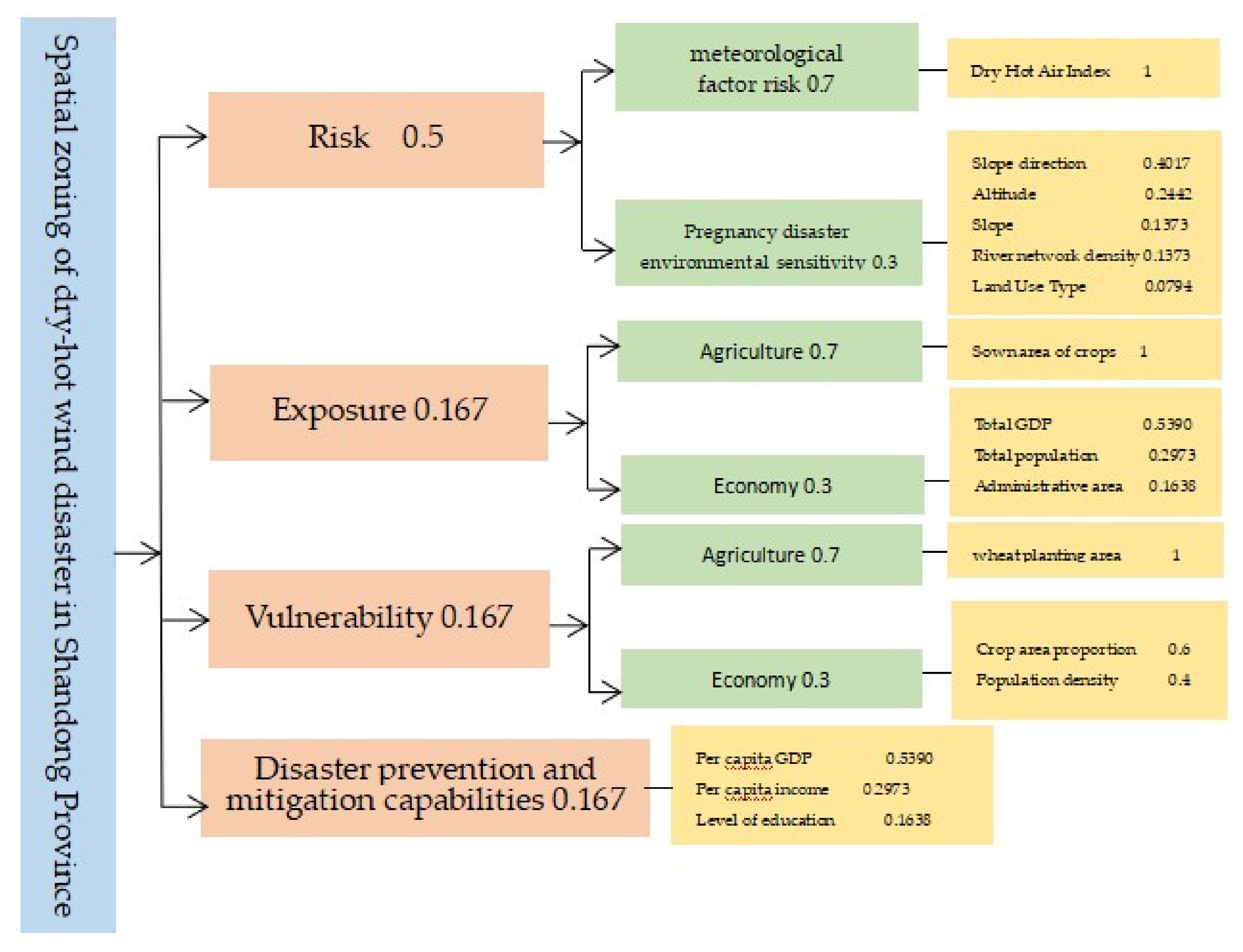
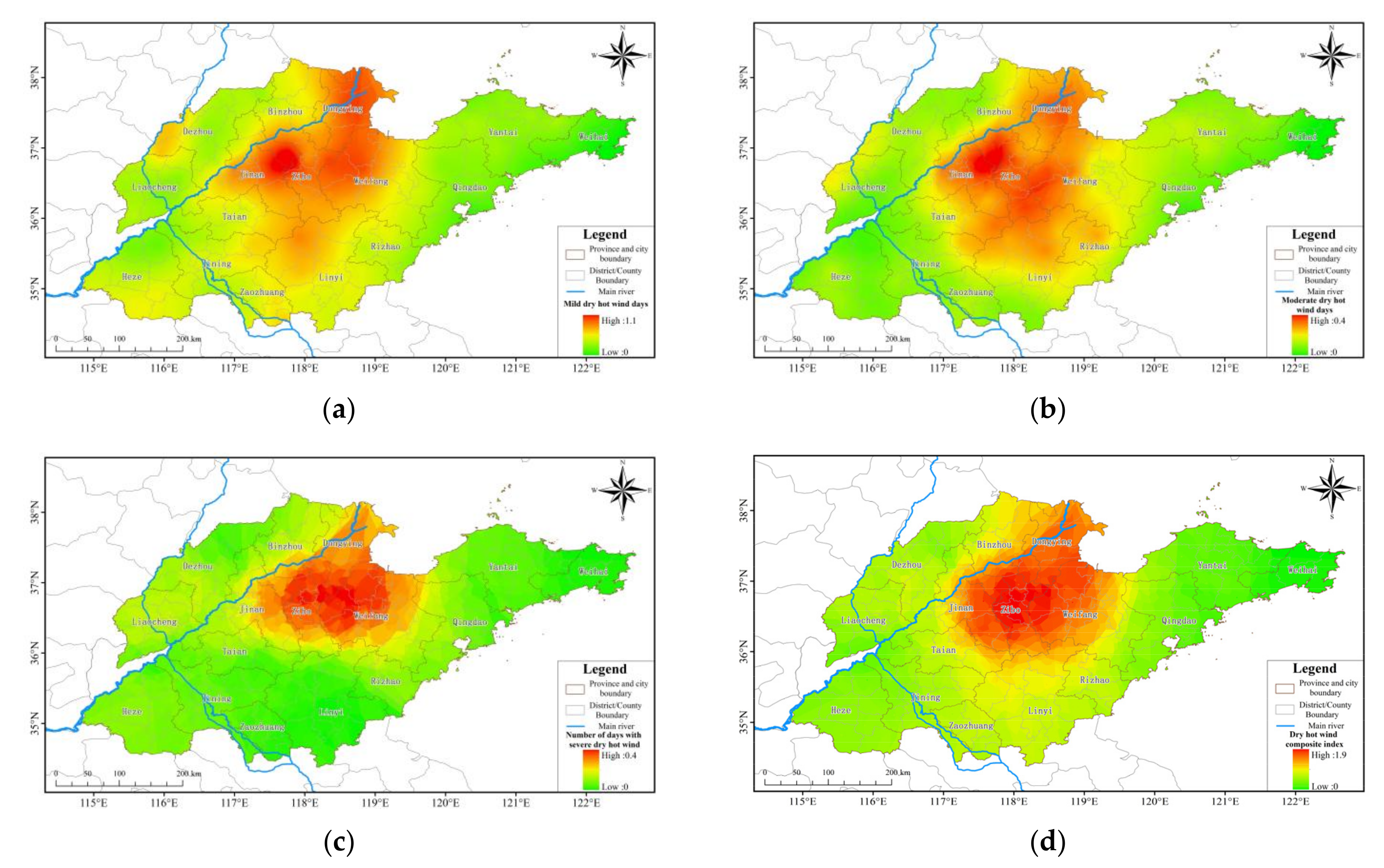
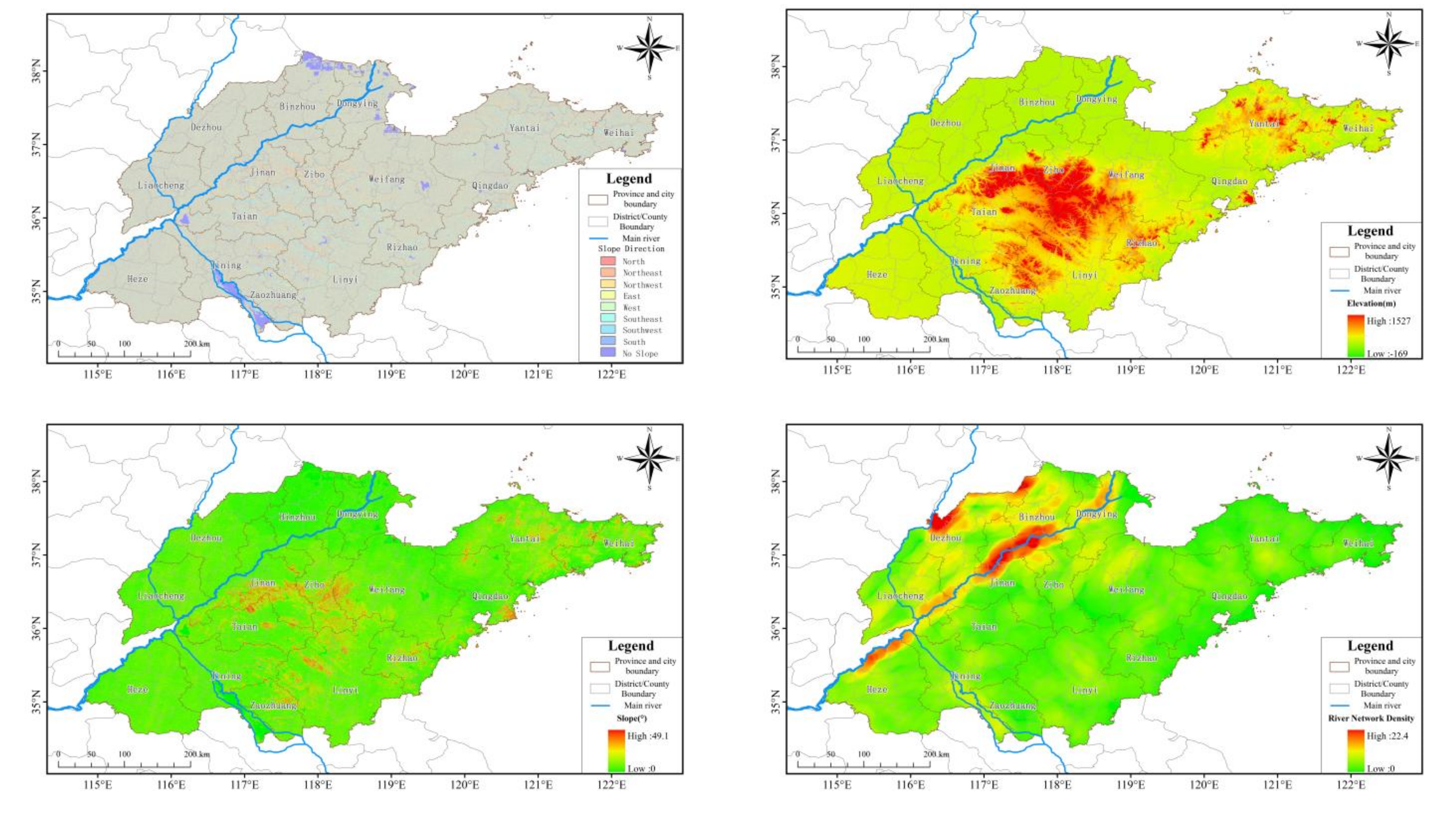
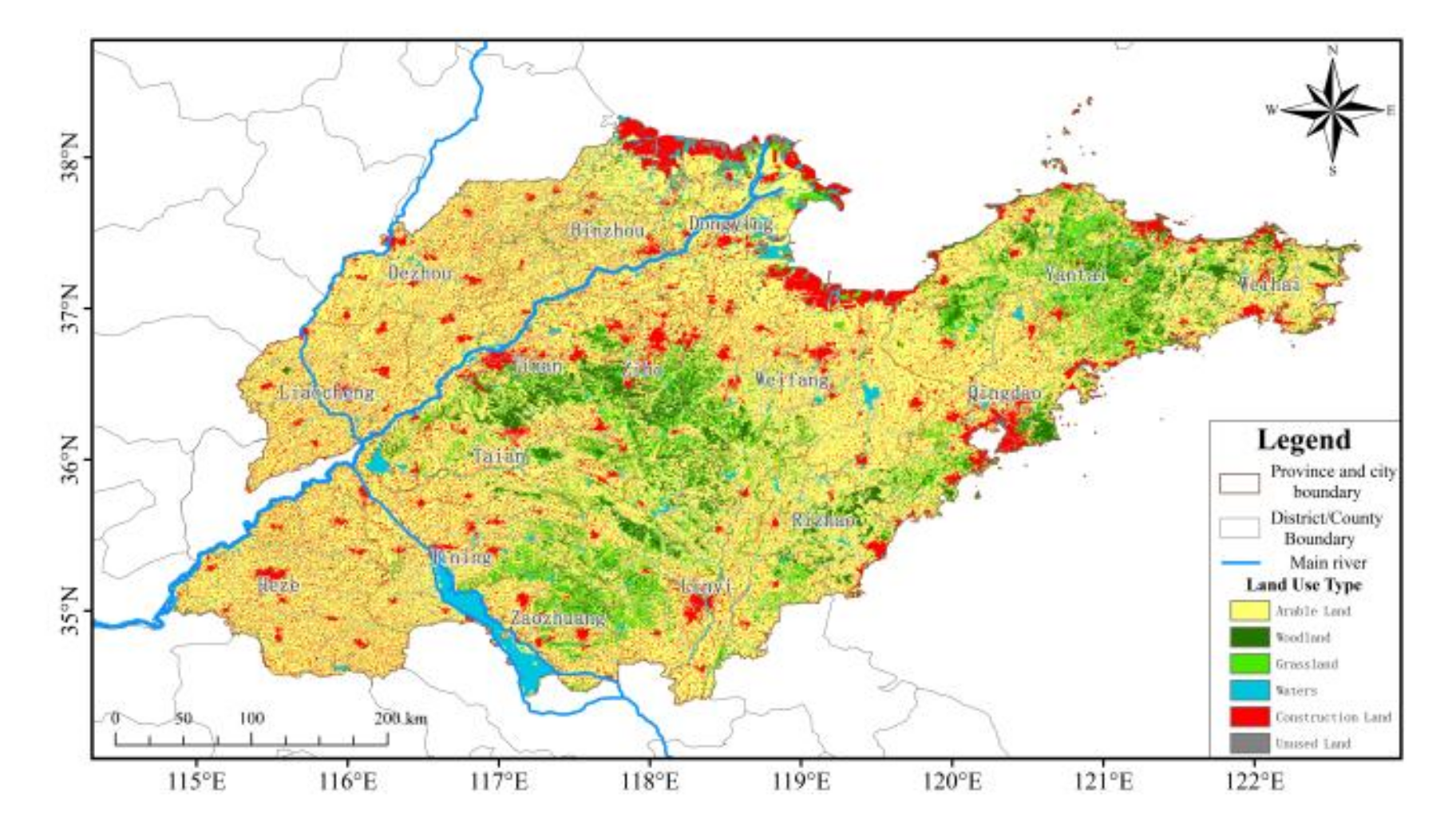
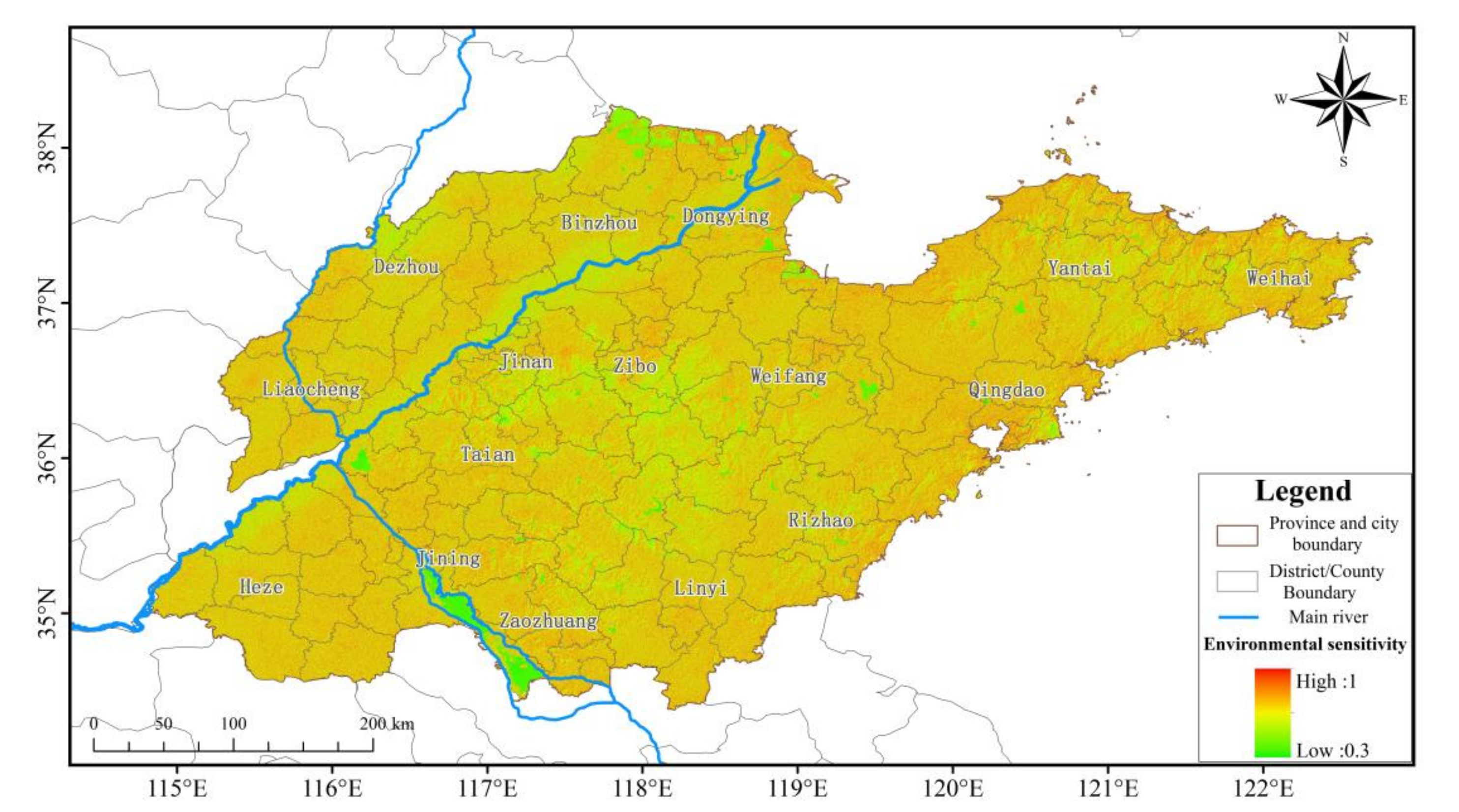
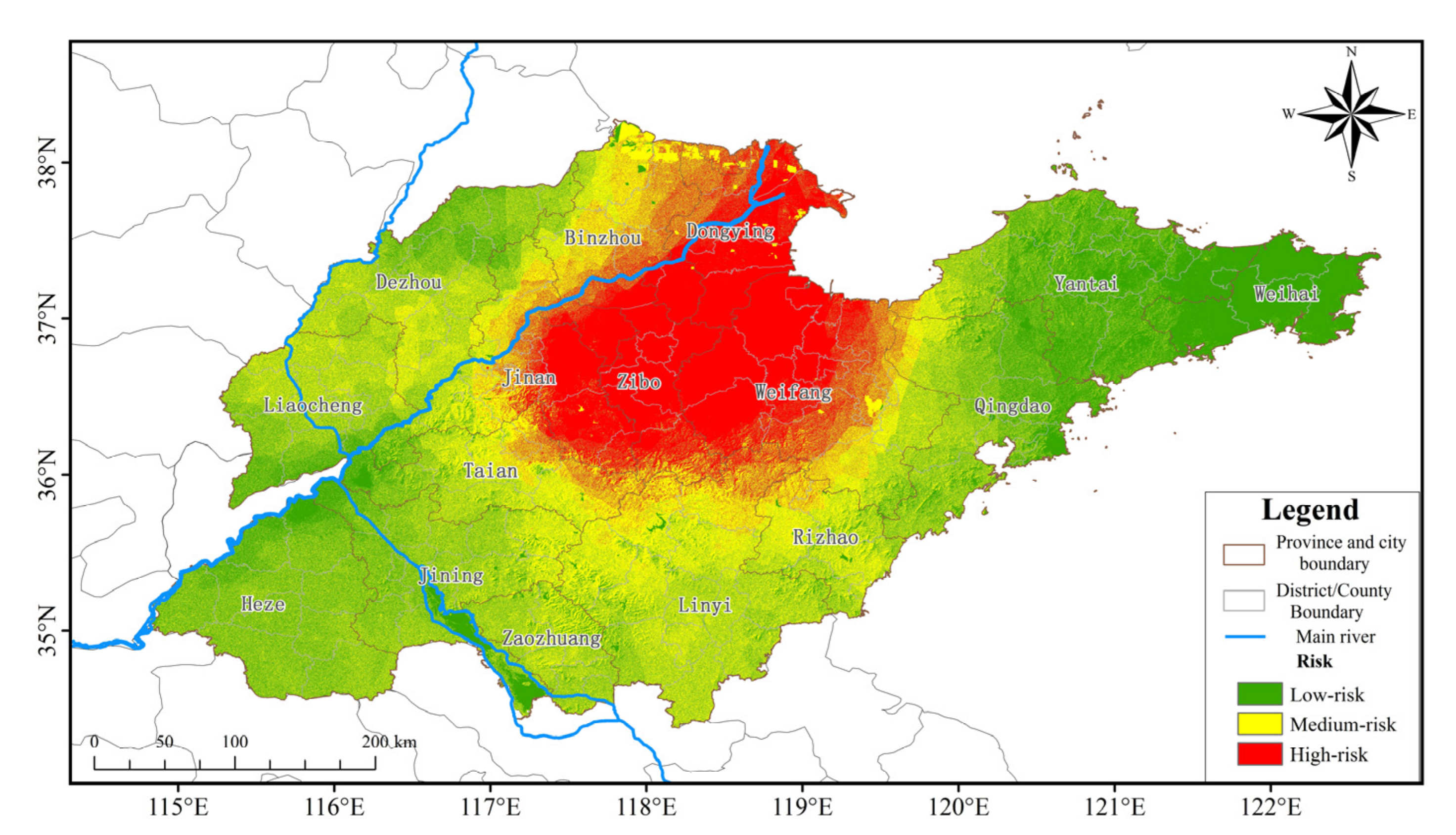
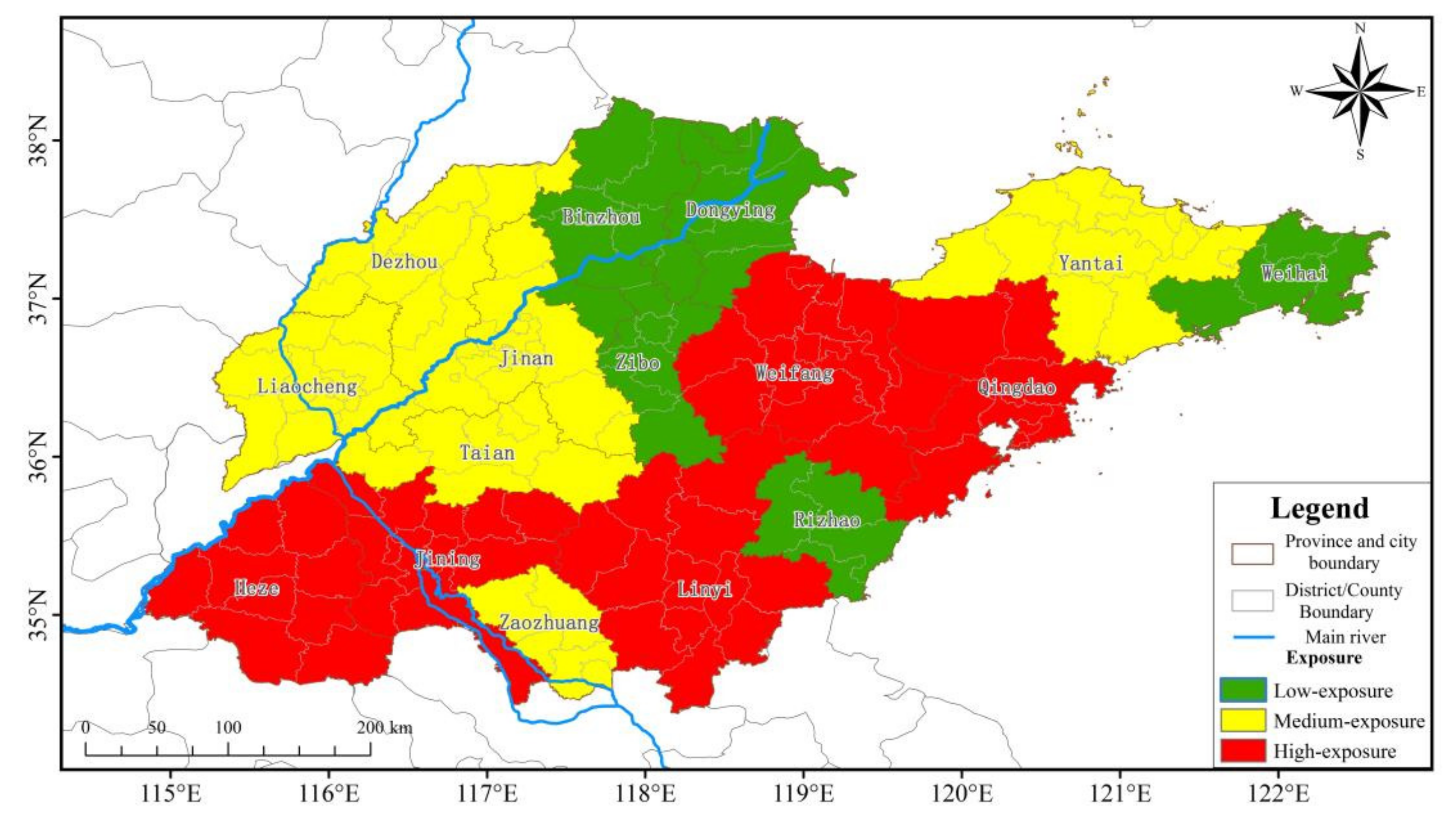
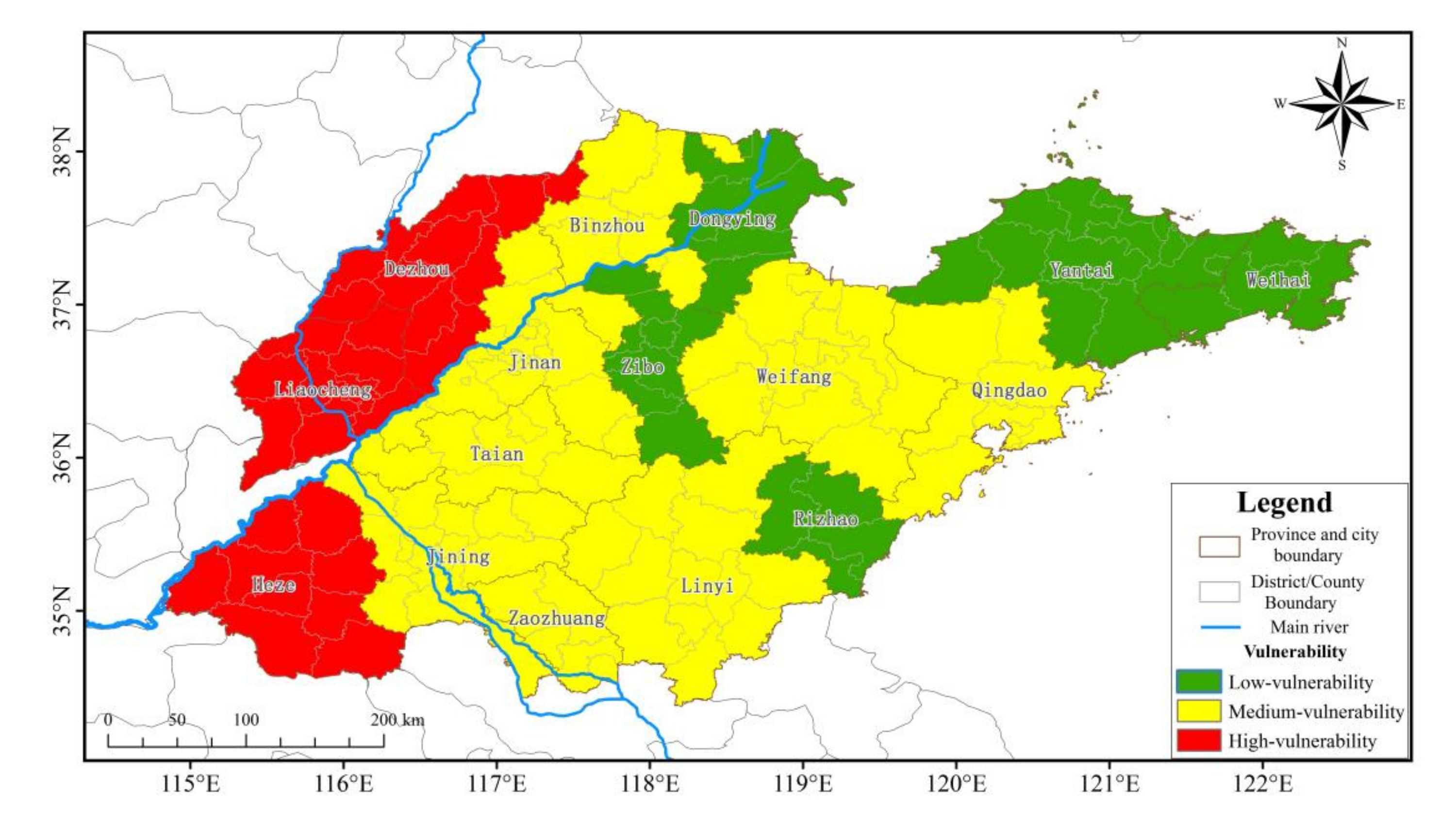
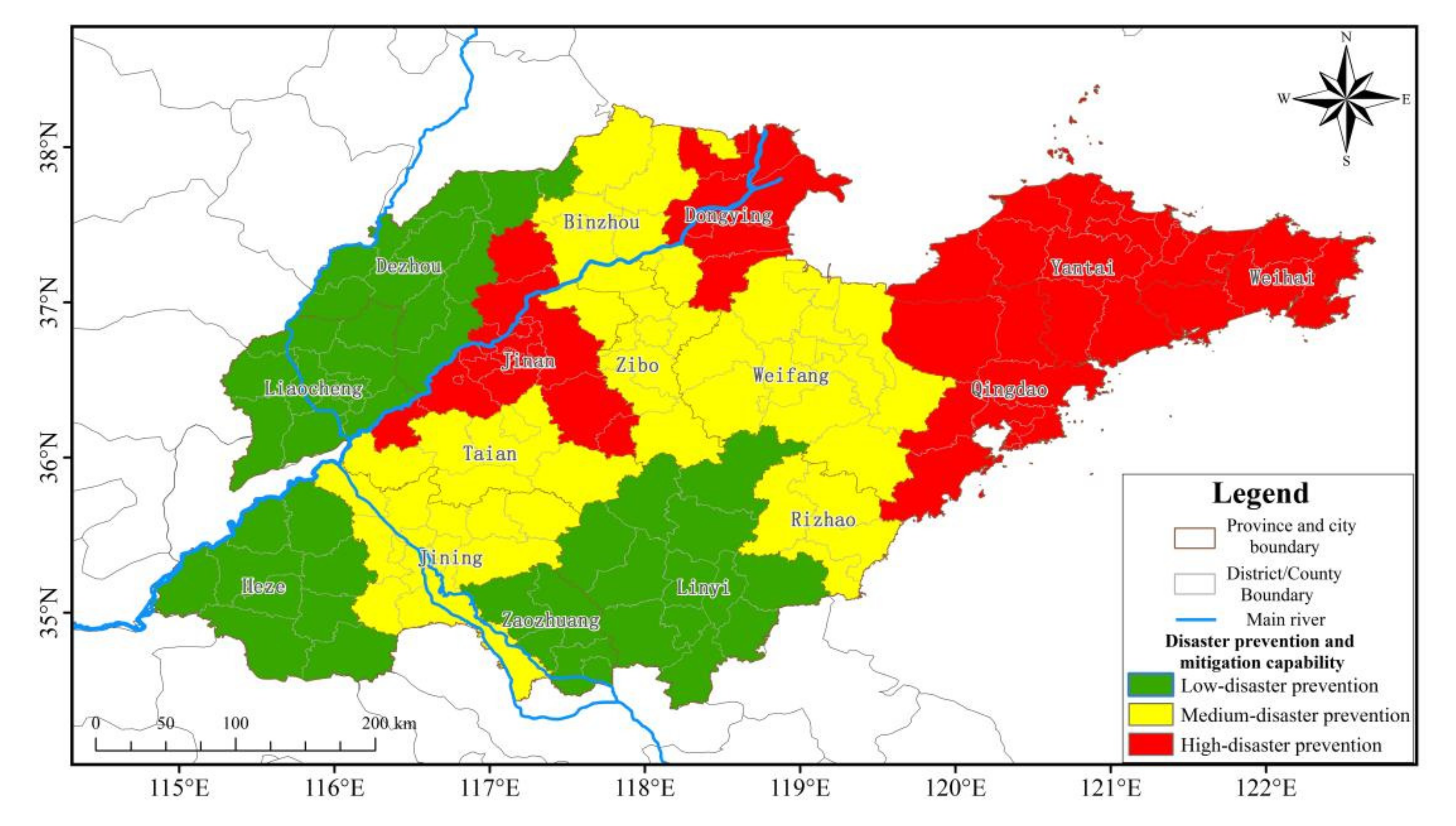
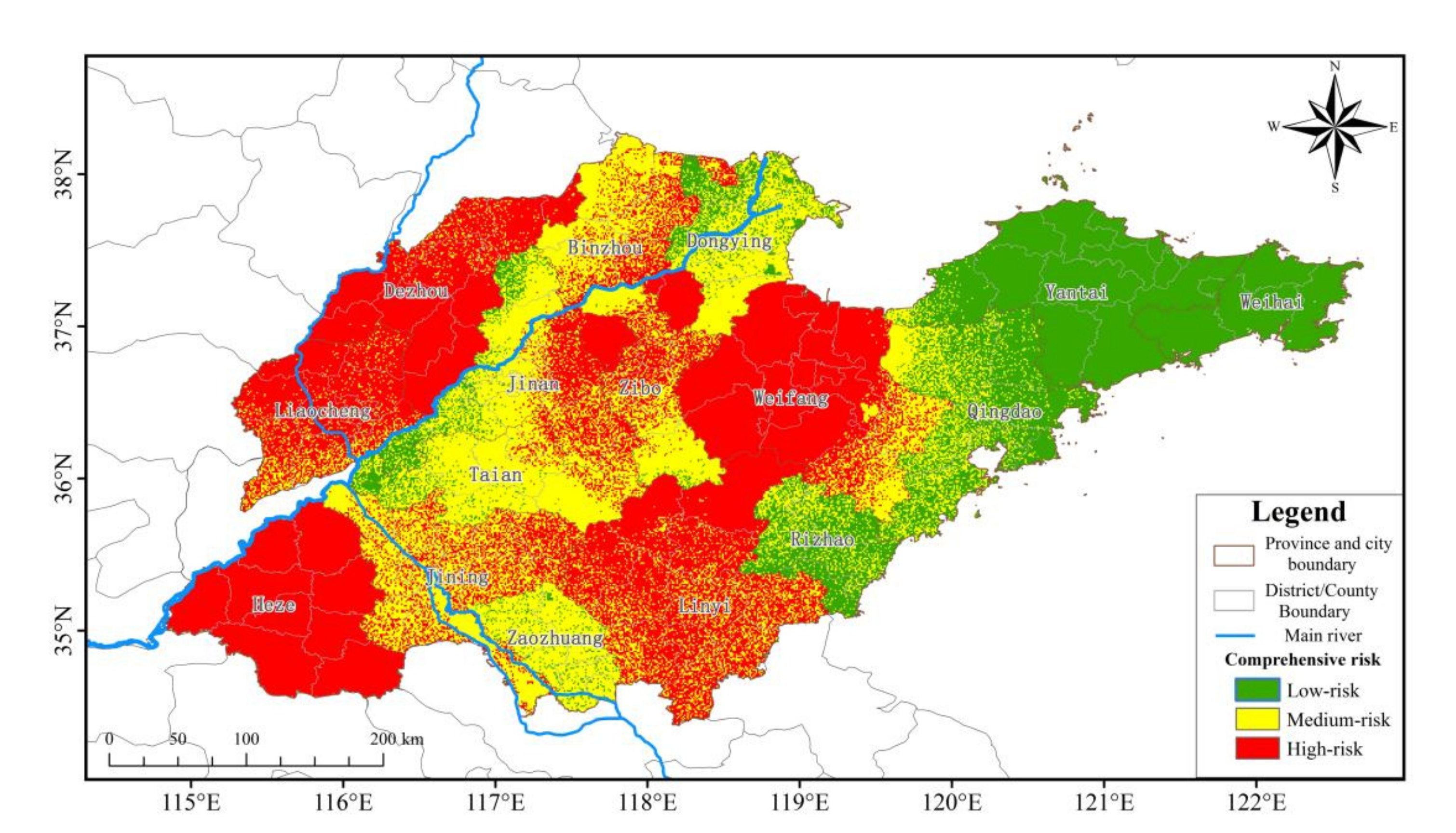



| Scale bij | Definition |
|---|---|
| 1 | The i factor is as important as the j factor. |
| 3 | The i factor is slightly more important than the j factor. |
| 5 | The i factor is more important than the j factor. |
| 7 | The i factor is much more important than the j factor. |
| 9 | The i factor is absolutely more important than the j factor. |
| 2, 4, 6, 8 | Between the noted levels. |
| M | 1 | 2 | 3 | 4 | 5 | 6 | 7 | 8 | 9 | 10 | 11 |
|---|---|---|---|---|---|---|---|---|---|---|---|
| RI | 0.00 | 0.00 | 0.58 | 0.90 | 1.12 | 1.24 | 1.32 | 1.41 | 1.45 | 1.49 | 1.51 |
| I | II | III | IV | V | Weights (W) | Matrix Product (AW) | AW/W | λmax | CI | CR | |
|---|---|---|---|---|---|---|---|---|---|---|---|
| I | 1 | 2 | 3 | 3 | 4 | 0.402 | 2.03 | 5.05 | 5.033 | 0.008 | 0.007 |
| II | 1/2 | 1 | 2 | 2 | 3 | 0.244 | 1.23 | 5.04 | CI = (λ − n)/n − 1 RI = 1.12 CR = CI/RI | ||
| III | 1/3 | 1/2 | 1 | 1 | 2 | 0.137 | 0.689 | 5.03 | |||
| IV | 1/3 | 1/2 | 1 | 1 | 2 | 0.137 | 0.689 | 5.03 | |||
| V | 1/4 | 1/3 | 1/2 | 1/2 | 1 | 0.079 | 0.399 | 5.05 | |||
| 25.18 | |||||||||||
| Area | Mild | Medium | Severe | |||||||
| 20 cm Soil Relative Humidity | Daily Maximum Temperature (°C) | Air Relative Humidity at 14:00 (%) | Wind Speed at 14:00 (m/s) | Daily Maximum Temperature (°C) | Air Relative Humidity at 14:00 (%) | Wind Speed at 14:00 (m/s) | Daily Maximum Temperature (°C) | Air Relative Humidity at 14:00 (%) | Wind Speed at 14:00 (m/s) | |
| Maximum Process Precipitation in Early and Mid-May | The Time Period is Mid to Late May | ||||||||
|---|---|---|---|---|---|---|---|---|---|
| Mild | Medium | Severe | |||||||
| Daily Maximum Temperature (°C) | Air Relative Humidity at 14:00 (%) | Wind Speed at 14:00 (m/s) | Daily Maximum Temperature (°C) | Air Relative Humidity at 14:00 (%) | Wind Speed at 14:00 (m/s) | Daily Maximum Temperature (°C) | Air Relative Humidity at 14:00 (%) | Wind Speed at 14:00 (m/s) | |
| <25 mm | 31 | ≤30 | ≥2 | ≥32 | ≤25 | ≥3 | ≥35 | ≤25 | ≥3 |
| ≥25 mm | ≥33 | ≤30 | ≥3 | ≥35 | ≤25 | ≥3 | ≥36 | ≤25 | ≥3 |
| I | II | III | Weights (W) | Matrix Product (AW) | AW/W | λmax | CI | CR | |
|---|---|---|---|---|---|---|---|---|---|
| I | 1 | 2 | 3 | 0.5 | 1.62 | 3.01 | 3.01 | 0.004 | 0.008 |
| II | 1/2 | 1 | 2 | 0.3 | 0.89 | 3.00 | CI = (λ − n)/n − 1 RI = 0.58 CR = CI/RI | ||
| III | 1/3 | 1/2 | 1 | 0.2 | 0.49 | 2.99 | |||
| 9 | |||||||||
| Aspect | South | South West | South East | No Slope | East | West | Northeast | North West | North |
|---|---|---|---|---|---|---|---|---|---|
| Score | 8 | 7 | 6 | 5 | 4 | 3 | 2 | 1 | 0 |
| Slope | 50–40° | 40–30° | 30–20° | 20–10° | 10–0° |
|---|---|---|---|---|---|
| Score | 5 | 4 | 3 | 2 | 1 |
| Land Use Type | Arable land | Woodland | Grassland | Waters | Construction Land | Unused Land |
|---|---|---|---|---|---|---|
| Score | 3 | 2 | 4 | 1 | 5 | 6 |
| High-Risk Area | Medium-Risk Area | Low-Risk Area | ||||
|---|---|---|---|---|---|---|
| Area (km2) | Ratio (%) | Area (km2) | Ratio (%) | Area (km2) | Ratio (%) | |
| Binzhou City | 4028.6 | 2.6 | 5582.1 | 3.6 | 1 | 0 |
| Dezhou City | 9594.5 | 6.1 | 1019.1 | 0.7 | 0 | 0 |
| Dongying City | 0 | 0 | 5104.5 | 3.3 | 2064.5 | 1.3 |
| Heze City | 12,083.8 | 7.7 | 0 | 0 | 0 | 0 |
| Jinan City | 1955 | 1.2 | 7069.6 | 4.5 | 1443.9 | 0.9 |
| Jining City | 297,514 | 1.9 | 8184 | 5.2 | 0 | 0 |
| Liaocheng City | 6488.6 | 4.1 | 2263.2 | 1.4 | 0 | 0 |
| Linyi City | 11,891.2 | 7.6 | 5329.6 | 3.4 | 0 | 0 |
| Qingdao City | 0 | 0 | 3915.1 | 2.5 | 7276.5 | 4.6 |
| Rizhao City | 0 | 0 | 1668 | 1.1 | 3679.8 | 2.3 |
| Taian City | 375.2 | 0.2 | 6609.2 | 4.2 | 875.1 | 0.6 |
| Weihai City | 0 | 0 | 0 | 0 | 5687.5 | 3.6 |
| Weifang City | 13,089.7 | 8.4 | 3027.8 | 1.9 | 0 | 0 |
| Yantai City | 0 | 0 | 323.5 | 0.2 | 13,652.5 | 8.7 |
| Zaozhuang City | 0 | 0 | 3958.7 | 2.5 | 581 | 0.4 |
| Zibo City | 1595 | 1 | 4420 | 2.8 | 87.2 | 0.1 |
Publisher’s Note: MDPI stays neutral with regard to jurisdictional claims in published maps and institutional affiliations. |
© 2022 by the authors. Licensee MDPI, Basel, Switzerland. This article is an open access article distributed under the terms and conditions of the Creative Commons Attribution (CC BY) license (https://creativecommons.org/licenses/by/4.0/).
Share and Cite
Wang, N.; Xue, X.; Zhang, L.; Chu, Y.; Jiang, M.; Wang, Y.; Yang, Y.; Guo, X.; Zhao, Y.; Zhao, E. Spatial Zoning of Dry-Hot Wind Disasters in Shandong Province. Sustainability 2022, 14, 3904. https://doi.org/10.3390/su14073904
Wang N, Xue X, Zhang L, Chu Y, Jiang M, Wang Y, Yang Y, Guo X, Zhao Y, Zhao E. Spatial Zoning of Dry-Hot Wind Disasters in Shandong Province. Sustainability. 2022; 14(7):3904. https://doi.org/10.3390/su14073904
Chicago/Turabian StyleWang, Nan, Xiaoping Xue, Lijuan Zhang, Yue Chu, Meiyi Jiang, Yumeng Wang, Yiping Yang, Xihui Guo, Yufeng Zhao, and Enbo Zhao. 2022. "Spatial Zoning of Dry-Hot Wind Disasters in Shandong Province" Sustainability 14, no. 7: 3904. https://doi.org/10.3390/su14073904
APA StyleWang, N., Xue, X., Zhang, L., Chu, Y., Jiang, M., Wang, Y., Yang, Y., Guo, X., Zhao, Y., & Zhao, E. (2022). Spatial Zoning of Dry-Hot Wind Disasters in Shandong Province. Sustainability, 14(7), 3904. https://doi.org/10.3390/su14073904





